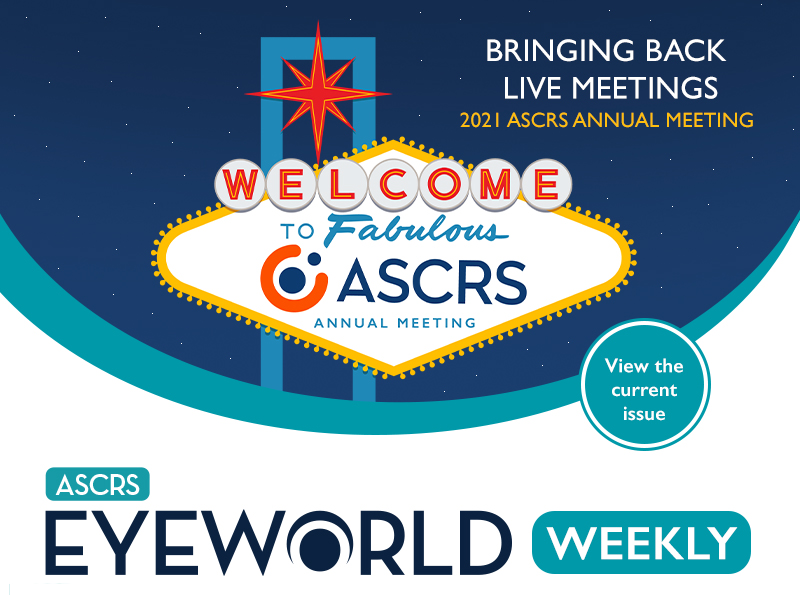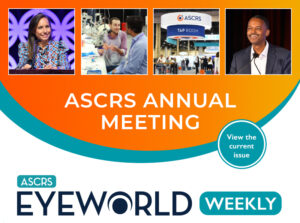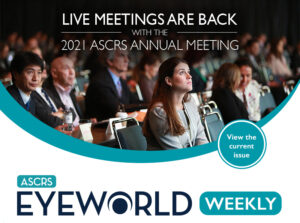
- Topline data from a Phase 3 study investigating first-in-class DED drop
- Research initiative focuses on new glaucoma treatments
- Phase 2 trial for oral treatment of diabetic retinopathy begins
- New SLT trial recruiting study sites
- ASCRS news and events
April 16, 2021 • Volume 27, Number 15
Topline data from a Phase 3 study investigating first-in-class DED drop
Bausch + Lomb and Novaliq announced positive topline data from its Phase 3 clinical trial of NOV03 (perfluorohexyloctane), which the company’s press release described as a first-in-class drop with a novel mechanism of action to treat dry eye disease associated with MGD. Both primary endpoints were met, with statistically significant changes from baseline in corneal staining and in dryness scores, assessed at day 15 and out to day 57. Secondary endpoints were also met in the trial, according to the companies. The multicenter, randomized, saline-controlled study included nearly 600 participants. According to the press release, NOV03 is a water-free, preservative-free solution that includes EyeSol technology from Novaliq. A second Phase 3 study is ongoing and if it yields positive results, it will allow for FDA filing in 2022, according to Bausch + Lomb.
Research initiative focuses on new glaucoma treatments
Santen Pharmaceuticals announced a research initiative with investigators at Massachusetts Eye and Ear and Ulster University to develop new, vision-preserving glaucoma treatments. According to the company’s news release, the research will look at whether targeting a part of the immune system (NLRP3 inflammasome) with a novel biologic (a therapeutic antibody called InflaMab) could stop degeneration of the optic nerve in glaucoma.
Phase 2 trial for oral treatment of diabetic retinopathy begins
Ocuphire Pharma announced the screening of the first patient in the ongoing ZETA-1 Phase 2 clinical trial evaluating APX3330 for patients with non-proliferative diabetic retinopathy and mild proliferative diabetic retinopathy. The effect of this drug on diabetic macular edema is being evaluated as a secondary outcome. Most approved treatments for these conditions are administered via anti-VEGF injections; APX3330 is designed as an oral treatment. According to the company’s press release, APX3330 has a novel mechanism of action to block downstream pathways regulated by transcription factor regulator Ref-1 to decrease abnormal activation of angiogenesis and inflammatory pathways. The ongoing ZETA-1 trial will enroll about 100 subjects to evaluate the efficacy of APX3330 against placebo over 24 weeks. The primary endpoint will be the percentage of patients who have a two or more step improvement on the Diabetic Retinopathy Severity Scale. Secondary endpoints are central subfield thickness, BCVA, safety, and tolerability.
New SLT trial recruiting study sites
The NEI-sponsored multicenter COAST (Clarifying the Optical Application of SLT Therapy) trial is accepting applications for study sites, with an application deadline of April 19. This study involves researchers from the U.S. and U.K. in collaboration with NEI to investigate the optimal energy level and frequency of laser therapy to treat glaucoma. The COAST trial website features more information on the study and application details.
ASCRS news and events
- Glaucoma Building Blocks: ASCRS announced this new, four-part educational series designed specifically for comprehensive ophthalmologists and anterior segment surgeons to gain a solid foundation in comprehensive glaucoma management.
- Grand Rounds: The next ASCRS Grand Rounds presented by Bascom Palmer Eye Institute will take place on April 28 at 8 p.m. ET.
- Annual Meeting: The ASCRS Annual Meeting Early Bird registration deadline is April 30. Register now and book housing early to reserve your preferred hotel in Las Vegas, Nevada, at the discounted Annual Meeting rate.
Research highlights
- A study published in the journal Ophthalmology assessed the impact of COVID-19 quarantine lifestyle changes on myopia among school children. The study included 1,001,749 students from Wenzhou City, Zhejiang Province, China, 7 to 18 years old, with June 2019 serving as a baseline. Follow-up exams were conducted in December 2019 (813,755 students) and June 2020 (768,492 students). In August 2020, 12,013 randomly selected students completed a survey that included their outdoor activity time and time spent in online courses pre-COVID-19 and during the COVID-19 quarantine, among other characteristics. The investigators found myopia prevalence increased from 52.89% at baseline to 53.9% in December 2019 and 59.35% in June 2020. High myopia also increased over this timeframe from 4.1% in June 2019 to 4.24% and 4.99% in December 2019 and June 2020, respectively. Grade was significantly associated with myopia and high myopia, according to the study. The researchers performed further analysis to reduce the influence of the large sample size and saw a stable, significant association between grade and myopia and high myopia. The investigators wrote that the results reveal that increasing educational burden has a greater effect on myopia development than age. This can be categorized into two Grade Stages: Grade Stage I (grades 1–6) representing myopia sensitive stage and Grade Stage II (grades 7–12) representing high myopia sensitive stage. This, they concluded, suggests different intervention strategies should be applied based on grade level.
- A randomized, controlled trial comparing the 12-month outcomes of traditional phaco cataract surgery with femtosecond-laser assisted cataract surgery (FLACS), performed at a single center, found no difference in vision, refraction, adverse postop events, or patient-reported outcome measures. The study, which included 400 patients, did find a greater correction index and smaller difference vector in intrastromal femto AKs compared to manual limbal relaxing incisions. With this, the investigators wrote that FLACS may provide more effective astigmatic correction. This paper is published in the British Journal of Ophthalmology.
Product news
- Alcon launched availability of UV filtering for its PanOptix and Vivity IOLs in Canada (AcrySof IQ PanOptix UV, AcrySof IQ PanOptix Toric UV, AcrySof IQ Vivity UV, and AcrySof IQ Vivity Toric UV).
- Katena Products announced its purchase and acquisition of ASICO, a company with a more than 35-year history as a provider of ophthalmic surgical instruments.
This issue of EyeWorld Weekly was edited by Stacy Jablonski and Liz Hillman.
EyeWorld Weekly (ISSN 1089-0319), a digital publication of the American Society of Cataract and Refractive Surgery (ASCRS), is published every Friday, distributed by email, and posted live on Friday.
Medical Editors: Eric Donnenfeld, MD, Chief Medical Editor; Rosa Braga-Mele, MD, Cataract Editor; Clara Chan, MD, Cornea Editor; Nathan Radcliffe, MD, Glaucoma Editor; and Vance Thompson, MD, Refractive Editor
For sponsorship opportunities or membership information, contact: ASCRS • 12587 Fair Lakes Circle • Suite 348 • Fairfax, VA 22033 • Phone: 703-591-2220 • Fax: 703-591-0614 • Email: ascrs@ascrs.org
Mention of products or services in EyeWorld Weekly does not constitute an endorsement by ASCRS.
Click here to view our Legal Notice.
Copyright 2021, EyeWorld News Service, a division of ASCRSMedia. All rights reserved.



